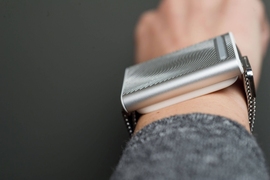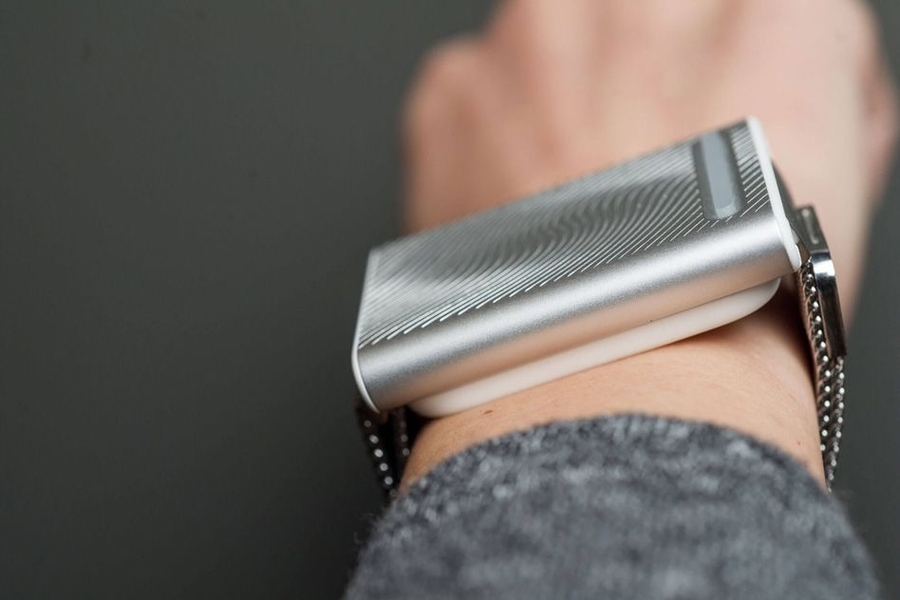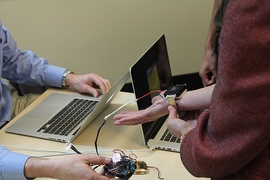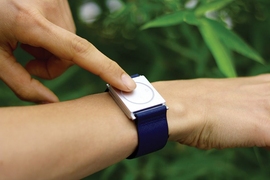Sitting in a stifling subway car or walking Boston’s cold winter streets may soon become more bearable, thanks to a “personal thermostat” wristband being released by MIT spinout Embr Labs.
For a design competition in 2013, four MIT engineering students created a smart wristband, called Wristify, that makes its wearer feel warmer or cooler through its contact with the skin on the wrist. After much fanfare, and a lot of research and development, the wristband will hit the shelves early next year.
The wristband, now called Embr Wave, has a flat aluminum top that includes a colored display users adjust from blue to red, to provide cooling or warming, respectively. The device works because the wrist is one of the most thermally sensitive parts of body. It’s also an area where people are most comfortable putting new wearable technologies.
Inside the wristband and touching the skin is a thermoelectric tile made of materials that change temperature when exposed to an electrical current. During heating, the current goes into the plate, creating heat waves. When cooling, the device dissipates heat with aid of the aluminum body, a popular material used for heat exchange.
The aim is to make “temperature personal,” says Embr Labs co-founder David Cohen-Tanugi PhD ’15. “We want people who are often uncomfortable and have little control over temperature to have more control and more relief in everyday life,” he says.
The startup is now taking orders for its first production run. It’s a moment the co-founders — including Sam Shames ’14 and Matthew Smith PhD ’12 — have been anticipating since the device first grabbed the public’s attention four years ago. “We’re excited to finally say ‘Yes’ to all the people who have been asking us for years, ‘Can I buy this yet?’” Shames says.
More broadly, the startup says the device could help curb energy use in buildings. Studies done at the Center for the Built Environment at the University of California at Berkeley, for instance, have shown that if a building’s thermostat neutral zone — the temperature range before air conditioning or heating kicks on — is extended by 1 degree, it can reduce energy consumption by up to 10 percent, depending on the geographical location and type of building. If extended by 2 degrees, it can reduce energy use by up to 20 percent.
Embr Labs believes its wristband can keep wearers comfortable enough to extend that neutral zone, and it’s preparing to test that idea at the Center for the Built Environment, as part of a National Science Foundation grant. “Given our backgrounds in the MIT energy community, getting that data is something very fulfilling for us,” Shames says.
A hot idea
The co-founders first met in Professor Jeffrey Grossman’s group at MIT. In 2013, they decided to compete together in the MADMEC design competition for materials science and engineering students, although they didn’t have an invention in mind at the time. Inspiration came one day over the summer, when the air-conditioner in their lab was so powerful they couldn’t concentrate.
“We were using all this energy cooling this lab space that was mostly empty, and we were actually uncomfortably cold,” Shames says. They wondered, “What if we could heat and cool people directly to make everyone more comfortable and save energy?”
That directed them to the concept of thermal comfort, which comes down to extreme sensations in different areas of the body. When you’re too warm, your face or hands may feel warmer than the rest of body. When you’re cold, you may feel colder in your toes or fingers. The team decided to reverse that concept and create a device that warms or cools one part of the body to increase comfort.
Going into rapid prototyping mode, the team built the first iteration of the Wristify wristband in the nick of time. “In true MIT fashion, we got the MADMEC demo working a few days before the competition,” Shames says.
All the scrambling paid off. The team took home the grand prize of $10,000 from the competition. Months of unanticipated media and public attention followed, which was “a mixed blessing,” Cohen-Tanugi says.
“When you’re a student, you’re not ready for that,” he says. “But we got hundreds of emails from people telling us their own temperature discomfort stories. We realized the problem was more widespread and severe than we thought.”
The team soon launched Embr Labs to commercialize the wearable, with guidance from professors and mentors in the Department of Materials Science and Engineering — including Grossman, the Morton and Claire Goulder and Family Professor in Environmental Systems — as well as the MIT Sloan School of Management and the MIT Venture Mentoring Service. That summer, the startup entered the Global Founders’ Skills Accelerator (now called delta v), which provided a “home base,” funds, and additional mentors “who gave us a rigorous base to design this product for real customers,” Cohen-Tanugi says.
Finding the sweet spot
In 2014, Embr Labs moved to the Industrial Lab co-working space in Cambridge, Massachusetts. Over the years, the startup has focused on engineering, design, and the physiology and psychology of temperature, to create a commercial device.
Despite being dubbed a “personal thermostat,” an important selling point of the wristband, Shames says, was ditching any mention of temperature, opting instead for a gradual hot-cold scale. “It’s less like a thermostat and more like a shower,” Shames says. “No one knows what temperature their shower is. You just set it to the sensation that feels good.”
“It’s a continuous spectrum,” Cohen-Tanugi adds. “You can incrementally adjust the sensation toward warm or cold until you find sweet spot.”
On the back end, the startup considered countless variables in engineering and human physiology and psychology to design the product. For starters, the team had to optimize for the various thermoreceptors on the skin of the wrist that all respond differently to certain temperature ranges, and to develop efficient ways to move heat around and out of a small wearable.
A key innovation was finding a way to deliver heat in waves. Consider again the shower analogy: After a few minutes in a hot shower, people become accustomed to the temperature, so they turn up the heat. To avoid that effect, the startup developed a method for delivering rhythmic waves of temperature that fade in and out, which stops users from acclimating to one sensation and constantly increasing the heat. Additionally, the speed of the waves delivered to the skin can have psychological impacts over time. Faster waves tend to energize people, while slower waves are more relaxing. This can affect a user’s thermal comfort, so the startup had to design around those considerations.
“We had to go from power electronics and mechanical engineering to physiology and psychology, in order to build a framework of dynamic heat rhythms that would pack as much temperature relief as possible in a sleek wristband,” Cohen-Tanugi says. “It was a whole new technological challenge.”
The consumer wristband could be just the beginning, Shames says. In the future, the temperature-controlling technology could see use in entertainment, virtual reality, and various communication applications. “Without getting into too much detail,” he says, “we’re exploring the rich space of human-temperature interaction.”










